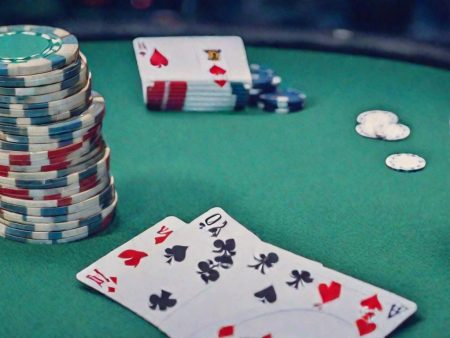Contents:
ToggleThe significance of completing a hand lies in how it can shift the dynamic of a hand, potentially allowing the player to make more aggressive bets and increase the size of the pot. Completing a hand can make a weaker hand stronger, enabling a player to put pressure on opponents.
Features of “Complete” in Poker
The concept of completing a hand can be applied both in online mobile poker games and at live tables. It carries several strategic components that influence gameplay decisions. Here are some important points to consider:
- Combination Dependent: “Complete” is directly tied to specific hand types such as flushes or straights. Players seek to complete their hands to improve their odds of winning. However, completing a hand does not guarantee a win; players must assess the strength of their hand in the context of their opponents’ actions.
- Understanding Probabilities: Recognizing the likelihood of completing a hand is essential for decision-making. Players who understand the odds can calculate whether it’s worth betting when attempting to complete their hand or if folding is a better choice.
- Bluffing with a Complete Hand: A player can also use the completion of a hand as part of a bluff. By betting after completing their hand, they may convince opponents that they have a strong combination, even if the hand is not as powerful as it seems. This strategy, known as a “complete bluff,” requires skillful reading of opponents.
- Variety of Combinations: Completing hands can involve different combinations. For example, a flush needs five cards of the same suit, while a straight requires a specific sequence. A player’s strategy should adapt based on the hand they are trying to complete.
- Card Observation: Players should keep an eye on the community cards to identify potential hands they could complete, as well as to track how the board develops in relation to their opponents’ possible hands. Understanding these dynamics helps players make more informed decisions.
Thus, in poker, completing a hand on the river or turn can significantly impact the flow of the game and the players’ strategies. Understanding hand probabilities and the ability to make decisions based on them are essential skills for success.
Read also: What is a call in poker and when is it profitable to make it.
Poker Examples Involving Completes
Poker players often find themselves aiming to complete their hands during a game. Here are a few examples illustrating when a hand is completed and how players can use this strategy:
- Flop Flush Completion: Alex holds two hearts, and the flop shows three hearts. He now has a flush draw and decides to bet, hoping the next card will complete his flush.
- Straight Completion on the Turn: Victor holds a 5 and 6, while the flop shows 3, 4, and 7. He needs either a 2 or 8 on the turn to complete his straight, so he decides to bet in hopes of receiving the right card.
- Three-of-a-Kind Completion: Alex has two 8s in his hand, and the flop reveals another 8. He now has three-of-a-kind and decides to bet, hoping his opponents do not improve their hands.
- Strong Hand Completion: If you have two suited cards like an Ace and King and the flop brings two more cards of the same suit, betting aggressively will put pressure on opponents who may also have suited cards but of lower value.
- Complete Bluffing: Imagine playing against opponents who seem to have weak hands. When a card appears that doesn’t help your hand but could potentially improve theirs, you might bet, hoping they will fold. This strategy, known as a complete bluff, can be risky but effective against passive players.
In these examples, evaluating the strength of the hand, understanding the odds of improvement, and recognizing the playing styles of your opponents are critical to making the right decisions.
Risks Associated with Completing a Hand
While completing a hand can enhance a player’s position, it’s not without risks. Some potential drawbacks to completing a hand include:
- Adding Chips Without Improving: When completing a hand, you are essentially committing additional chips to the pot. If you fail to improve, especially if your opponents bet aggressively, you could end up losing a significant portion of your stack.
- Being Read as a Bluff: If opponents suspect you’re using the completion of a hand as a bluff, they might raise, forcing you to fold.
- Helping Opponents Complete Their Hands: By completing your hand, you might inadvertently help an opponent improve their position. For example, if you complete a straight, the next card could give your opponent a higher straight.
- Wasting Resources: Sometimes, completing a hand may simply be a waste of time and chips, particularly in tournaments where every decision can have significant consequences.
Successful use of the “complete” strategy requires careful analysis, understanding of opponents’ playstyles, and the ability to assess the potential risks and rewards. There’s no one-size-fits-all strategy in poker, and each hand has its own unique dynamics. When the risks outweigh the benefits, players should consider folding instead of completing their hand.
Read also: What is a bub in poker.
In conclusion, poker players looking to increase their chances of success should understand the probabilities and make informed decisions based on the situation at hand. Additionally, if you’re considering entering online poker games, choose licensed platforms to ensure a safe and trustworthy gaming environment. Want to improve your skills? Check out the blog on poker and casino tactics – play smarter and win more!
FAQ: What is a complete set in poker
What does “complete set” mean in poker?
In poker, a "complete set" typically refers to a set of three cards of the same rank formed when a player has a pocket pair and one matching card appears on the board.
How is a complete set different from trips in poker?
A complete set involves hitting three-of-a-kind using a pocket pair and one community card, while trips are formed with one of your hole cards and two matching community cards. Sets are usually more disguised and harder for opponents to detect.
Why is a complete set considered a strong hand?
A complete set is strong because it often dominates other hands and is difficult to read. Its disguised nature allows players to extract value from opponents holding weaker hands or overpairs.
How can a player maximize value with a complete set?
To maximize value, a player should consider slow playing in early rounds to trap opponents or betting aggressively on later streets to build the pot, depending on the board texture and opponents’ tendencies.
What are the risks of playing a complete set too passively?
The risks include giving opponents a chance to outdraw your hand with straights, flushes, or higher combinations. Failing to protect your set on coordinated boards can lead to costly losses.
How does board texture impact the strength of a complete set?
On dry boards (with fewer draw possibilities), a complete set is very strong. However, on wet boards with potential straights or flushes, the set’s strength decreases, requiring more cautious play.
What common mistakes do players make with complete sets?
Common mistakes include overplaying the set on dangerous boards, failing to extract value against weaker hands, and slow playing in situations where protection is necessary. Adapting to the table dynamics is key to successful set play.






